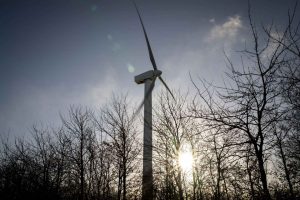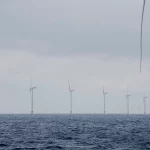This website uses cookies to improve your experience. We'll assume you're ok with this, but you can opt-out if you wish. Read more
Denmark versus Russian energy
Denmark versus Russian energy
This week the Social Democratic administration presented a plan for a large-scale conversion to green energy (DK). It wants to phase out natural gas and greatly increase solar and wind energy production by 2030. “When we become greener, we weaken Putin,” said PM Mette Frederiksen. “And … we slow the climate change that is destroying our Earth.”

Windmill at Avedøre Holme, Denmark. Photo: Mads Claus Rasmussen © Ritzau Scanpix
In Denmark, as in other European countries, many households have seen large increases in their heating and electricity bills – up to 400 percent. Last month Frederiksen said that Denmark must become independent of Russian natural gas (DK) as quickly as possible. The first step, she said, is for private households with gas furnaces to switch to district heating or individual heating pumps.
Biomass, solar and wind
But under the current rules, the conversion will take up to seven years, said Kim Mortensen, head of Danish District Heating, who appealed to the Climate Ministry to find a quicker solution. There was a demand for district heating and waiting lists even before Russia’s invasion of Ukraine. The process of laying pipes and installing equipment in homes is time-consuming, and the current procedure of canvassing individual households for approval delays the conversion further.
Only a small portion of Denmark’s energy comes from natural gas, though. The country is a leader in renewable energy production and consumption. Half of its electricity is supplied by wind and solar, and half of its district heating is fueled by biomass. Earlier, Denmark had aimed to reduce fossil sources of district heating to 10% and to stop the sale of gas and diesel cars altogether. Now it intends to quadruple energy production from solar and wind installations in an ambitious program that requires changes in regulations as well as in tolerance by the public. Several other parties, both supporters and opposition, think the plan is weak on details.
Energy firm to cut ties with Russia
The Danish energy company Ørsted said it will end its partnership with Gazprom, the Russian energy conglomerate, in 2030. With the imposition of sanctions, the company was urged to stop collaboration with Gazprom (DK). It can’t do so until its current contract expires in 2030, though. It doesn’t intend to renew the contract, and it has condemned the Russian invasion. It also plans to stop using Russian biomass and coal in its power plants and to donate profits from its Russian imports to humanitarian aid for Ukraine.
Nordic natural gas to Poland
As much of Europe tries to wean itself off Russian natural gas, Denmark is helping to transport Norwegian gas to Poland. The Baltic Pipe project (DK), a 900-kilometer link that had been suspended because of environmental concerns, resumed construction in Denmark just after the Russian invasion. It is to start operations in October, and it will eventually be able to supply about half of Poland’s consumption. The country now gets around two-thirds of its natural gas from Gazprom.
But the project is not a pure gain for European energy sourcing. Norway is shipping as much gas as possible, and the exports to Poland will mean less gas for other countries in the region. Some of them are considering liquified natural gas from the US and elsewhere to replace the Russian supply.
Nuclear redux
Nuclear power is another alternative that has returned to the limelight. At the end of last year, the European Commission proposed a “taxonomy” of investments in energy sources (DK) that placed natural gas as well as nuclear power in the “renewable” category. They were described as necessary elements in a transitional period if Europe is to become the first carbon-neutral continent by 2050. The EU estimates that reaching this goal will require cutting net greenhouse gas emissions in 2030 by 55 percent from the level in 1990, and that this will require investments of one billion euros in green energy.
This designation brought a protest from Denmark and three other EU member states. Natural gas is of course a fossil fuel, even if it is cleaner than coal and oil. And although nuclear doesn’t emit CO2, it is viewed as a security risk that produces dangerous radioactive waste. The Commission’s favorable characterization of these sources, the dissenting countries argue, would draw investments away from genuinely renewable energy sources. Either from environmental principles or economic interest or both, the Danish Chamber of Commerce, which represents several companies that provide green energy solutions to Europe, hopes the proposal will fail. Denmark voted down nuclear power production in 1985, and its last reactor closed in 2001.
Varieties of safety
The proposal has the backing of the largest EU members, however. France has invested massively in nuclear energy. The Commission’s researchers see nuclear power to be as favorable on green criteria as solar and wind. While the UN has said that it won’t be possible to keep the rise in global temperature under 1.5 degrees without nuclear power, the issue remains one of the most contentious in the climate debate. Germany is phasing out its nuclear plants because of safety concerns, but it favored the Commission’s taxonomy because it wanted to replace nuclear power with natural gas. But after the Russian sanctions, it’s instead using coal electricity that will increase pollution and mortality, and reconsidering the closures.
While the Danish EU MPs from the Conservative and Liberal parties support the proposal, Climate Minister Dan Jørgensen and the Social Democratic administration have vowed that Denmark will continue to fight it. The EU Parliament votes on it in July, and there’s no clear indication of how much support the opposition has gathered.


